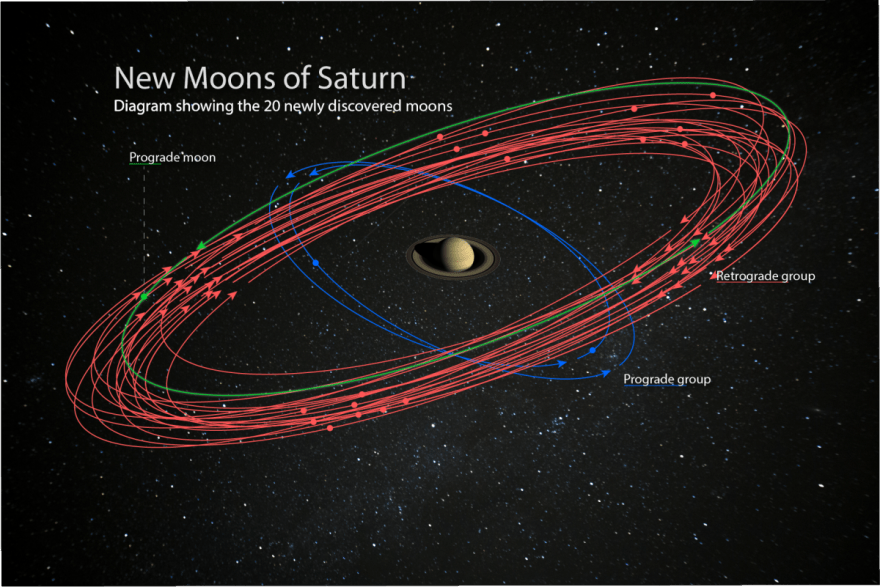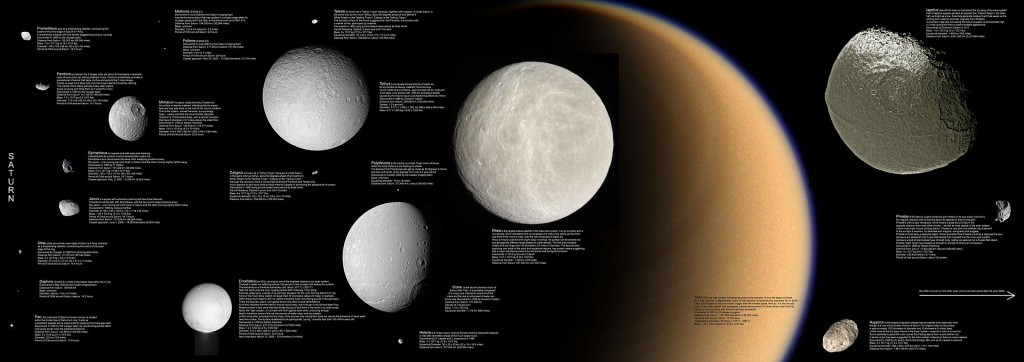The reign of Jupiter, named after the father of the Olympian gods, has been long and sweet. Aside from being the largest planet in the Solar System, it was this gas giant that demonstrated in the 17th century that planets other than Earth can support a system of moons. Between its size, powerful magnetic field, and system of 79 moons, Jupiter looked set to remain the king of the planets
But it looks like Saturn, named after the father of Jupiter in Greco-Roman mythology, might have just knocked Jupiter off that pedestal. Thanks to a team led by famed astronomer Scott S. Sheppard 20 new moons have been discovered orbiting Saturn. That brings the total number of Saturnian (or Cronian) satellites to 82, putting it ahead of Jupiter’s 79. And the best part? You can help name them!
The discovery was announced earlier today (Monday, Oct. 7th) by the International Astronomical Union’s Minor Planet Center (MPEC). The team responsible for the discoveries included Sheppard, David Jewitt of UCLA, and Jan Kleyna of the University of Hawaii using the 8.2 meter Subaru Telescope located at the Mauna Kea observatory in Hawaii.

These newly-discovered satellites all fall into Saturn’s outer group of moons, which are divided into three different clusters based on the inclinations of their orbits around the planet. They are known as the Inuit, Norse, and Gallic groups, which named after mythological figures derived from these respective cultures’ traditions.
Two of the newly discovered prograde moons fit into the Inuit group, which have inclinations of about 46°, while the retrograde moons are part of the Norse group. The two satellites closest to Saturn have prograde motions and an orbital period of about two years while the more-distant moons – which include two retrograde and one prograde moon – have orbital periods of more than three years.
The other prograde moon has an orbital inclination close to 36°, which is similar to other moons in the Gallic group. Interestingly, the two new Inuit moons are believed to have been part of a larger moon that was broken apart in the past. By studying these and other satellites that have were previously-undiscovered, astronomers can learn a great deal about the formation and evolution of the Saturn system.
As Sheppard explained in a recent Carnegie Science press release:
“Studying the orbits of these moons can reveal their origins, as well as information about the conditions surrounding Saturn at the time of its formation… This kind of grouping of outer moons is also seen around Jupiter, indicating violent collisions occurred between moons in the Saturnian system or with outside objects such as passing asteroids or comets.”

Similarly, it is possible that the newly-discovered retrograde moons are also fragments from a larger moon since they have similar inclinations to other previously known retrograde moons. However, one of the new prograde moons orbits much further from Saturn than the
This is in keeping with the most widely-accepted theory of how the Solar System formed billions of years ago (aka. the Nebula Hypothesis). Shortly after the Sun was born of the nebula’s gas and dust, the remaining material fell into a disk that gradually accreted to form the planets. In a similar vein, a gas and dust ring likely surrounded Saturn during its formation which gradually accreted to form its moons.
If some of these newly-discovered moons were part of a larger moon that broke apart, and there was a large amount of gas and dust present at the time, then there would have been a lot of friction and collisions with the fragments of the moon. This would have cause the newly-created moons to spiral into Saturn’s atmosphere and be lost.
“The fact that these newly discovered moons were able to continue orbiting Saturn after their parent moons broke apart indicates that these collisions occurred after the planet-formation process was mostly complete and the disks were no longer a factor,” said Sheppard.
These 20 satellites represent the latest in a series of moons discovered by Sheppard and his colleagues in the outer Solar System. Last year, Sheppard was responsible for the discovery of 12 new moons orbiting Jupiter – which is what brought the gas giant’s total to 79.
“Using some of the largest telescopes in the world, we are now completing the inventory of small moons around the giant planets,” said Sheppard. “They play a crucial role in helping us determine how our Solar System’s planets formed and evolved.”
The Carnegie Institution of Science then hosted an online contest to name five of these moons, which recently resulted in them being named Pandia, Ersa, Eirene, Philophrosyne, and Eupheme – all the names of Zeus’ descendants. This time around, Carnegie is hosting another online contest to name five of the newly-discovered Saturnian moons. The details of the contest and instructions on
The efforts of Sheppard and his colleagues are helping to advance our understanding of the outer planets and the processes that formed them. Meanwhile, the success of the naming contests is a testament to
“I was so thrilled with the amount of public engagement over the Jupiter moon-naming contest that we’ve decided to do another one to name these newly discovered Saturnian moons,” Sheppard said. “This time, the moons must be named after giants from Norse, Gallic, or Inuit mythology.”
In the meantime, Jupiter may have a bunch of moons that are waiting to be discovered. And even if it does have fewer satellites than Saturn, it will always have the most inhospitable radiation environment!
Further Reading: Carnegie Science

